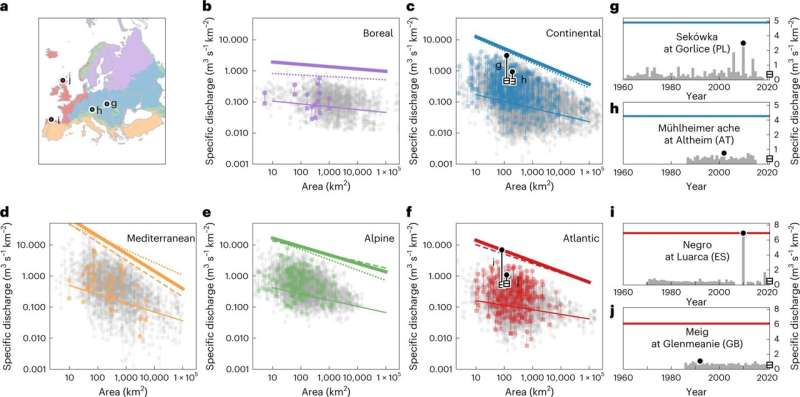This article has been reviewed according to Science X's editorial process and policies. Editors have highlighted the following attributes while ensuring the content's credibility:
fact-checked
peer-reviewed publication
trusted source
proofread
How looking beyond our borders would improve preparedness for extreme floods

Almost all extreme flooding across Europe could be anticipated by looking at previous major events in other similar parts of the continent, according to a new study.
"Megafloods," such those on the Rhine tributaries in Germany in 2021, are extreme events that vastly exceed those previously experienced in each location, causing significant damage and deaths. But they can be hard to anticipate due to their rarity and the lack of data at many sites, which means flood defenses and emergency response plans are often insufficient, exacerbating the impacts on communities.
A team of European scientists, including experts at the UK Centre for Ecology & Hydrology (UKCEH), analyzed river discharges—the volume of water flowing through a channel per second—from 8,000 gauging stations across Europe from 1810–2021 to identify historic megafloods.
They found 95.5% of megafloods could have been anticipated based on previous events at locations elsewhere in the continent with similar climate and variability in terms of how much water that rivers discharge in response to factors such as rainfall and temperature.
UKCEH Principal Hydrologist Jamie Hannaford was a co-author of the study, published in Nature Geoscience. He explains, "Our findings demonstrate that while the most extreme floods shock local communities, they are not usually surprising if we take a continental-scale viewpoint."
"In the UK we already look beyond local catchments and consider events from other locations when assessing flood risk, but this is still limited to within our borders. A continental scale approach could give us additional information on our susceptibility to extreme floods. This would provide 'worst case scenarios' to help ensure appropriate flood defense measures and preparations can be implemented, thereby limiting damage when extreme floods do happen."
The catastrophic flooding in July 2021 at the Rhine tributaries in Germany, and rivers in the Netherlands, Belgium and Luxembourg, was up to four times larger than any event on record in the region. It took residents and authorities by surprise, and caused more than 200 deaths and damage worth US $40 billion. However, the new study showed that the discharge rate was similar to floods in northern Austria in 2002.
Examples in the UK include the 2009 floods in the Derwent catchment in Cumbria, where the discharge was 58% greater than the second largest event on record there, but not as extreme as flooding in similar catchments in Norway.
Mr. Hannaford and fellow UKCEH hydrologist Steve Turner were among the team of 56 researchers representing institutes in 29 countries, led by the Vienna University of Technology.
A study in 2019 by the same research team found that flood events are becoming increasingly severe in north-western Europe, with northern England and southern Scotland among the areas most affected, but decreasing in severity in southern and Eastern Europe.
More information: Miriam Bertola et al, Megafloods in Europe can be anticipated from observations in hydrologically similar catchments, Nature Geoscience (2023). DOI: 10.1038/s41561-023-01300-5
Journal information: Nature Geoscience
Provided by UK Centre for Ecology & Hydrology




















